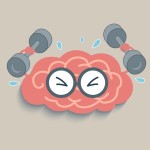MOVMENT FOR BRAIN HEALTH – ADULTS 
“I think therefore I am” – Rene` Descartes
“Movement is critical to every other brain function, including memory, language, emotion and learning. Our ‘higher brain functions’ derived from movement and still depend on it.” —John Ratey, M.D.
How times and thinking have changed – from the perspective that our brains and bodies are separate to a view of their complete interdependence.
Obviously there is no single answer to the question of supporting brain health, but the brain and body are clearly connected and movement plays a significant role here.
First there is the importance of aerobic activity. In addition to improving blood flow it enhances the production of a factor called BDNF that supports more connections in the brain.
Next to explore is exactly how movement happens. Simply, we get the idea to do something and our brains send messages to our muscles that in turn pull on our bones creating an action. What is interesting here is that there is a closed loop of sorts where the quality with which we move creates more refined pathways in the brain which in turn not only improve the quality of future movement, but also have the possibility to refine our thinking and feeling. This is a foundational idea articulated by Moshe Feldenkrais in the development of his movement-based method.
“What I am after isn’t flexible bodies, it’s flexible brains”- Moshe Feldenkrais
Having been a practitioner of this method for the last thirteen years I would say this work does both.
One of Moshe’s first students and one of my teachers Anat Baniel has purported that several essential qualities when applied to movement support not only better movement, but also improved brain function overall. Three of these are
- Movement with close attention to how you are moving
- Slowing down which allows for the previous
- Variation – critical to keep your brain from basically getting stuck in ruts
Feldenkrais® and Anat Baniel movement lessons are specifically designed to support theses qualities.
If these “essentials”, and quality movement for a better quality of life are particularly interesting you might enjoy reading Anat’s book MOVE INTO LIFE.
Pretty much any activity either gross or fine motor that involves both a physical and cognitive component support a healthy brain. Possibilities range from yoga, martial arts and rock climbing to playing a musical instrument or engaging in crafting.
As we age many of us become concerned about both declining physical and mental function. The idea of use it or lose it is important here. Regarding movement, variation is critical. I recently saw a clip on YouTube that is a stellar example of what senior fitness programs could be in contrast to sitting on a stationery bicycle or using an upper body cycle day after day in the interest of exercising.
For the interested, Michael Merzenich PhD, one of the luminaries in the world of brain plasticity and now in his 70s addresses brain health and aging extensively in his book SOFT WIRED.
To conclude movement is critical for a healthy brain throughout life. Although traditional repetitive methods of “working out” are of some help, movement that is variable and engages our minds is a significant piece of the puzzle.
If you are interested in learning more about how movement can help you be and stay sharp I offer $25 half hour consultations to those who have not worked with me before. To schedule call 206-842-4608 or email moving@drizzle.com.
